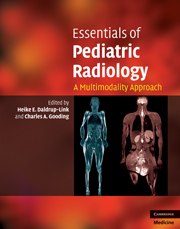Book contents
- Frontmatter
- Contents
- List of contributors
- Preface
- 1 The normal child: growth and development of the infant and child; frequent and important normal variants
- 2 Neonatal imaging
- 3 Congenital cardiac malformations
- 4 Pediatric trauma
- 5 Nontraumatic pediatric emergencies
- 6 Infections, inflammations and HIV
- 7 Pediatric tumors
- 8 Ischemia in children
- 9 Metabolic bone disorders
- 10 Skeletal dysplasias and syndromes
- 11 Transplant imaging in children
- 12 Iatrogenic devices
- 13 Radiation protection in children undergoing medical imaging
- Index
- References
13 - Radiation protection in children undergoing medical imaging
Published online by Cambridge University Press: 06 December 2010
- Frontmatter
- Contents
- List of contributors
- Preface
- 1 The normal child: growth and development of the infant and child; frequent and important normal variants
- 2 Neonatal imaging
- 3 Congenital cardiac malformations
- 4 Pediatric trauma
- 5 Nontraumatic pediatric emergencies
- 6 Infections, inflammations and HIV
- 7 Pediatric tumors
- 8 Ischemia in children
- 9 Metabolic bone disorders
- 10 Skeletal dysplasias and syndromes
- 11 Transplant imaging in children
- 12 Iatrogenic devices
- 13 Radiation protection in children undergoing medical imaging
- Index
- References
Summary
Introduction
The discovery of the X-ray was one of the most significant advances in medicine. Use of X-ray modalities in medical care, including radiography, fluoroscopy and angiography, and computed tomography, account for the vast majority of diagnostic imaging procedures performed in adults and children. Despite the benefits, the principle concerns for medical imaging that uses X-rays are the real and potential biological consequences. The fundamental issues with the ALARA (as low as reasonably achievable) principle as it relates to the cost (or risk) benefit ratio have been discussed in depth previously. Suffice it to say that even while the benefits of medical imaging are often not well defined or understood, the decision to perform medical imaging must weigh heavily in favor of the benefit side of this equation. While the radiation risk cannot be eliminated, it can be reduced by familiarity with, and ultimately adaption of, strategies to reduce radiation exposure in children.
There are some fundamental considerations when addressing the topic of radiation protection. First there is the underlying assumption that there is no safe level of radiation. This is the ALARA (as low as reasonably achievable) principle. The ALARA principle is a consequence of the linear no-threshold model, where what we know occurs (e.g., a significantly increased risk of developing cancer) at higher levels of radiation exposure is extrapolated to lower levels of radiation. The next point is that the following material will address the stochastic (versus deterministic) risks of radiation.
- Type
- Chapter
- Information
- Essentials of Pediatric RadiologyA Multimodality Approach, pp. 390 - 402Publisher: Cambridge University PressPrint publication year: 2010
References
- 1
- Cited by



